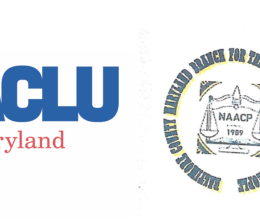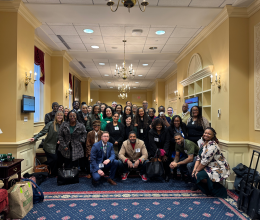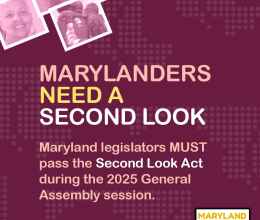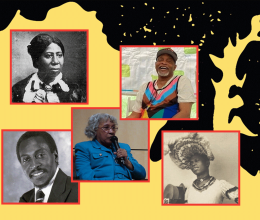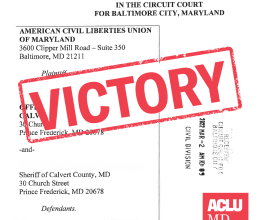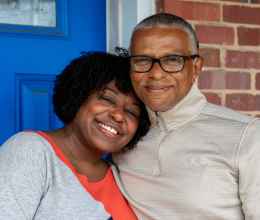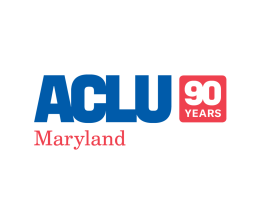
BALTIMORE COUNTY, MD – Today, a group of Baltimore County voters joined with the Baltimore County Branch of the NAACP, the League of Women Voters of Baltimore County, and Common Cause - Maryland in filing a federal lawsuit challenging the racially discriminatory and unlawful redistricting plan approved by the Baltimore County Council Monday evening. Despite a massive outcry from local voters and many options to create a fair plan offered by civil rights groups, the County Council voted for a plan that violates the racial fairness commands of the Voting Rights Act, which are meant to protect against diluting the voices of Black, Indigenous, and other Voters of Color, as well as BIPOC candidates. Black voters challenging the illegal redistricting plan are Charles Sydnor, Anthony Fugett, Dana Vickers Shelley, Danita Tolson, Sharon Blake, Gerald Morrison, and Niesha McCoy.
“Yesterday evening, the Baltimore County Council adopted Bill 103-21, Revision of Councilmanic Districts. The Council's defiant action violates the 15th Amendment of the United States Constitution, and The Voting Rights Act, the Federal statute designed to enforce the 15th Amendment,” said Dr. Danita Tolson, President of the Baltimore County NAACP. “By adopting this illegal legislation, the Baltimore County Council joins the ranks of infamous state and local politicians throughout the country who are adopting redistricting legislation designed specifically to solidify their incumbency and disenfranchise African American and other minority voters. It is abundantly clear that the Baltimore County Council's adopted redistricting legislation will result in continued dilution of African American and minority voting strength. Today, the Baltimore County NAACP along with other like’minded individuals and organizations have no choice but to seek redress in Federal court to stop such action.”
Census data shows that over the last two decades, racial diversity in Baltimore County has increased substantially, with Black, Latinx, and Asian populations each growing significantly. Now, Black, Indigenous and People of Color (BIPOC) residents make up 47 percent of the County’s population, up from 25 percent in 2000 and 35 percent in 2010. Despite this population growth, the redistricting plan engages in racial gerrymandering to creates six majority white districts. While Black people constitute 30 percent of the voting-age population of Baltimore County, under the County Council’s plan they will only have a fair opportunity to elect representatives of their choice in just one of seven County Council districts. Conversely, while non-Latinx white people constitute 55 percent of the voting-age population of the County, they will control six of the seven County Council districts. The 2021 redistricting plan engages in racial gerrymandering by packing excessively high numbers of Black voters into its one majority-Black district, while also dividing a politically-cohesive Black communities into other Council districts, which illegally dilutes the voting influence of all Black voters.
“Despite the growing number of People of Color in our community, the Baltimore County Council drew racially gerrymandered maps,” said Ericka McDonald, League of Women Voters of Baltimore County co-president. “They ignored census data and violated theVoting Rights Act. The League will push for these maps to be redrawn to protect all voices in Baltimore County – not the political interest of the council.”
Plaintiffs seek a declaration from the federal court that the redistricting plan violates the Voting Rights Act, an injunction prohibiting Baltimore County from holding elections under this unlawful system, and an order mandating a redistricting plan for the election of members of the County Council and Board of Education that comports with the Voting Rights Act, as well as with all other relevant constitutional and statutory requirements.
“Throughout this year’s redistricting process, we and residents across Baltimore County called on Council members to follow the law and put the people above politics,” said Joanne Antoine, Executive Director of Common Cause – Maryland. “Instead, they chose to ignore the law at the expense of free and fair elections. The county’s voting districts don’t belong to politicians, they belong to the people. The people, specifically Black voters, have a right to have a voice in choosing their representatives and should not have to live a decade under an illegal map.”
“I take no pleasure in having to sue my County government,” said Plaintiff Charles E. Sydnor III, a voter in Baltimore County and Maryland State Senator representing District 44. “I have no doubt that its act will have an adverse effect on this entire County for years to come. It pains me that in 2021 we still find ourselves fighting against tactics meant to dilute voices in the political arena. It pains me that today we must sue for something as fundamental and basic as our full right to equally participate in the local governance of our communities.”
“Baltimore Council members have voted for a redistricting plan that is racially discriminatory,” said Plaintiff Dana Vickers Shelley, a voter in Baltimore County and Executive Director of the ACLU of Maryland. “Despite being in clear violation of the Voting Rights Act, they remain determined to protect their own self interests — their place and positions — above the rights of thousands of Black voters in the County who deserve fair representation. However comfortable Council members might feel about passing an illegal plan, the Voting Rights Act still exists and Black voters are determined to defend it and our right to have elected officials who represent us and our communities.”
“I served as President of the Baltimore County Branch of the NAACP in 2001 when we challenged the redistricting map,” said Plaintiff Anthony Fugett, a voter in Baltimore County. “The County Council listened to our request and created what is today the 4th District. Now in 2021 the current Council decided not to listen to some of its citizens who requested a map that represented the racial makeup of the County. Instead, they made their reelection the priority for the map. It is a sad day for Baltimore County when a citizen has to take the county you live in to Federal court to do their job.”
“Once again the politicians have decided what is best for the people who voted them into office,” said Plaintiff Gerald Morrison, a voter in Baltimore County. “I don't understand this. They have got to realize that we are the ones who put them in the office to do what we like to have done. The majority of the people did not want the redistricting map that the Baltimore County Council put forth. The majority of the people also felt that there could be a way that we could have two majority black districts and everything would be fine. The NAACP along with the ACLU have proven that it could be done. However, Baltimore County Council decided to go along with the map that everybody else was against."
"As a resident of the 4th District in Baltimore County, it is disgraceful that the Baltimore County Council doesn't care about its minority residents,” said Plaintiff Niesha McCoy, a voter in Baltimore County. “By approving this redistricting map, they knowingly violated section 2 of the Voting Rights Act."
The civil rights groups worked with an experienced emographer to analyze census data for Baltimore County, and proposed several alternative redistricting plans that fulfill the purpose of the Voting Rights Act by expanding election opportunities for Black, Indigenous, and People of Color voters relative to their increasing share of the population.
The County Council plan’s exclusion of BIPOC voters from electoral opportunities perpetuates a long history of race discrimination in Baltimore County. Until 2002, only white candidates were elected from every County Councilmanic district, all of which were configured to encompass majority white populations. In 2001, civil rights activists, including the Baltimore County NAACP and ACLU of Maryland, urged the County to adopt a plan that would comply with the Voting Rights Act and that would ensure that Black residents could vote for a candidate of their choice to represent their community. The resulting plan included one district that had a majority Black population and in the 2002 election, voters in the district made history by electing the first-ever Black representative to the Baltimore County Council. Consistently since then, residents of the majority-Black district have elected Black representatives, while the remaining majority-white districts have all elected only white officials. The groups assert that this pattern shows “the persistence of racially polarized voting and the importance of districting in addressing resulting minority vote dilution.”
Plaintiffs are represented by Andrew D. Freeman of Brown, Goldstein & Levy, John A. Freedman, Mark D. Colley, and Michael Mazullo of Arnold & Porter, and ACLU of Maryland Legal Director Deborah Jeon.
###
